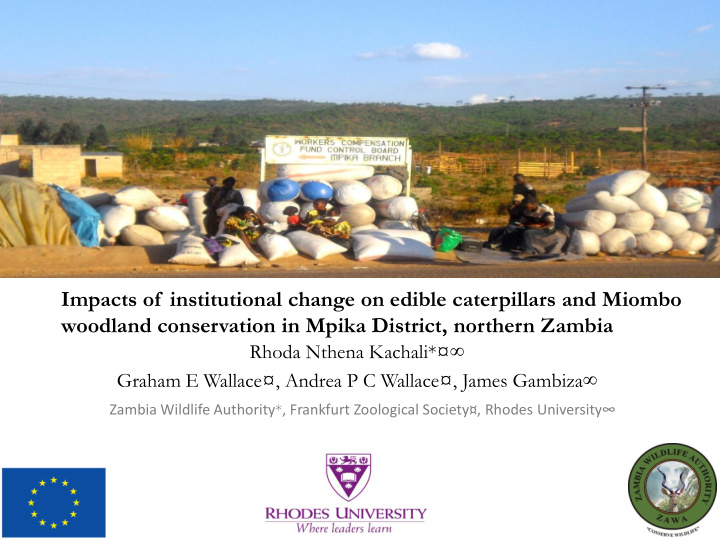



Impacts of institutional change on edible caterpillars and Miombo woodland conservation in Mpika District, northern Zambia Rhoda Nthena Kachali*¤∞ Graham E Wallace¤, Andrea P C Wallace¤, James Gambiza ∞ Zambia Wildlife Authority * , Frankfurt Zoological Society¤, Rhodes University∞
Study area
Study Area Kopa Mukungule Mpumba 3
Miombo: The social woodland • Over 100 million inhabitants • Key habitat for charismatic herbivores (rhinos, elephant) • Supports agricultural systems (chitemene/slash and burn) • Fire is a key management tool and driver of ecosystem change Kapanda Lupili Falls Picture by Carl F. Huchzermeyer
Commercially important members of the moth family Saturnidae in Mpika Gynanisa maya Gonimbrasia zambesina
Why caterpillars? • Healthy woodlands = healthy caterpillar population Environmen t • Code of conduct for fire and caterpillar management practices Self organizing Institutions • Sustainable protein and income source Benefits • The ideal Community based Natural Resource Management case! Win win
The problem Perceptions of caterpillar abundance and prices 2010 – 2014 100 50 90 45 80 40 % change of caterpillar abundance 70 35 Kwacha (ZMW) per kg 60 30 50 25 40 20 30 15 Abundance Price Mumpa 20 10 Price Chipumi 10 5 0 0 2010 2011 2012 2013 2014
Socio-ecological system Ecosystem health Codes of conduct and behaviour Caterpillar with regards to fire management abundance and caterpillar Benefits Government policy/Institutions
Research questions • Which institutions govern natural resource use, particularly fire and edible caterpillars, in Mpika district? • What knowledge do stakeholders have about these institutions? • How effective are these institutions in governing edible caterpillar and fire use? • How have these institutions changed over time? • Does institutional change have an impact on edible caterpillar abundance?
Institutions: a definition “Commonly understood “Commonly understood codes codes of behaviour that of behaviour that potentially potentially reduce reduce uncertainty, mediate uncertainty, mediate self- self-interest and facilitate interest and facilitate collective action” collective action” Ostrom and Cox 2010* Ostrom and Cox 2010* *Ostrom, E. and Cox, M. (2010) Moving beyond panaceas: a multi-tiered diagnostic approach for social-ecological analysis. Environmental Conservation 37, 451 – 463.
Methods 377 Semi-structured interviews 6 key informant interviews 9 focus groups Observing/following harvesters Females = 52% Males = 48% Respondents with experience harvesting caterpillars = 82%
Institutions for Natural Resource Management Traditional institutions: Primary custodians Perceived in communities as the Chiefs, Village Headmen enforcers of rules and regulations Primary policy makers Government of the Republic Not directly involved in day to day of Zambia management of resources Community Resource Government attempt at community Boards (CRBs) participation Role and authority established by statute Non-governmental Facilitators with financial and technical organizations (NGOs) resources Not beneficiaries but provide support
Who is responsible for enforcing sanctions? 58% 33% 5% 1% 1% 1%
What are the codes of conduct for caterpillar management? 1% 1% 16% Early burn 42% Not specified Local taboos No cutting trees Specified harvest time 40%
Codes of conduct: Fire management • “ You should burn early in order to have more caterpillars” • “You only burn when the Chief says so” • 84% of respondents knew about fire regulations • “You should burn early in order not to destroy the environment ”
Are institutions effective? • Sanctions are not common. Only 19% knew someone who had been punished for breaking rules • “I will be taken to the police if I dare punish anyone” Senior Chief • “I only had authority to punish people in the old days” Chief
Are Institutions effective? Traditional institutions: Lack legal authority to enforce rules Chiefs, Village Headmen and regulations Lack capacity to enforce laws due to Government of the Republic lack of resources of Zambia Strong focus on agricultural production Community Resource Lack legal authority to enforce Boards (CRBs) regulations Prone to elite capture Non-governmental Short term projects May inadvertently exacerbate elite organizations (NGOs) capture
Differences in government policy: Caterpillars versus maize Edible caterpillars Maize No subsidies Subsidize production Only 3 forestry officers for entire district 26 Agriculture extension (42,000 km 2 ) officers No land use policy for non-timber forest Secure land for farms and maize products production Not promoted as part of the national Maize seen as food security food basket Price determined by market Guarantees market price for producers
What happens during actual enforcement of Codes of conduct? Greater adherence to rules when livelihoods were at stake Mpumba - Charcoal Kopa - Charcoal and Caterpillars Mukungule - Chitemene No actual policing of rules and regulations because of reduced social acceptance
Conclusions so far • Institutional prescriptions that are devoid of meaningful content have failed to engender community participation • Government policy and action: Dis-incentive for conservation action Contribute to erosion of traditional institutions • Benefits from caterpillars may not be a sufficient incentive to conserve The ideal CBNRM case?
Next steps A deeper look at the key assumptions under-pinning CBNRM Benefits lead to pro-environmental action? Ownership leads to pro-environmental action? Win-win is possible?
Acknowledgements • Rhodes University – Dr. James Gambiza • Zambia Wildlife Authority – Mr. Chuma Simukonda • European Union • CREATE project and Frankfurt Zoological Society (FZS) - Dr. Graham Wallace, Dr. Andrea Wallace, and Dr. Anke Fischer • University of Zambia - Professor Keith Mbata and Dr. Bridget Bwalya Umar
Recommend
More recommend